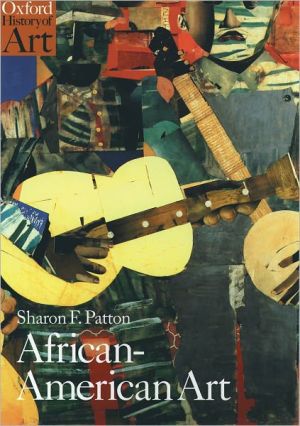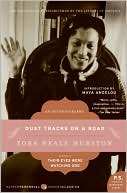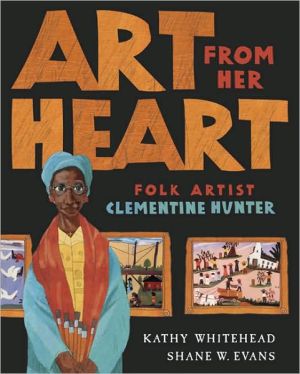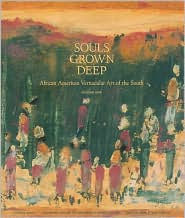African-American Art
From its origins in early eighteenth century slave communities to the end of the twentieth century, African-American art has made a vital contribution to the art of the United States. African-American Art provides a major reassessment of the subject, setting the art in the context of the African-American experience. Here, Patton discusses folk and decorative arts such as ceramics, furniture, and quilts alongside fine art, sculptures, paintings, and photography during the 1800s. She also...
Search in google:
From its origins in early eighteenth century slave communities to the end of the twentieth century, African-American art has made a vital contribution to the art of the United States. African-American Art provides a major reassessment of the subject, setting the art in the context of the African-American experience. Here, Patton discusses folk and decorative arts such as ceramics, furniture, and quilts alongside fine art, sculptures, paintings, and photography during the 1800s. She also examines the New Negro Movement of the 1920s, the era of Civil Rights and Black Nationalism during the 1960s and 70s, and the emergence of new black artists and theorists in the 1980s and 90s. New evidence suggests different ways of looking at African-American art, confirming that it represents the culture and society from which it emerges. Here, Patton explores significant issues such as the relationship of art and politics, the influence of galleries and museums, the growth of black universities, critical theory, the impact of artists collectives, and the assortment of art practices since the 1960s. African-American Art shows that in its cultural diversity and synthesis of cultures it mirrors those in American society as a whole.Publishers WeeklyPatton has written an excellent and comprehensive introduction to the historical development of African American visual art. She provides much new information on the art making of both slaves and freemen in the 18th and 19th century while later providing a broad art-historical context for black modernists. Pointing out that crafts did not necessarily precede fine art making during slavery, she examines African retentions (and Indian influences) in 18th-century black ceramics and architecture; black women and quilting; abolitionism and the rise of black landscape painters like Robert Duncanson; and sculptor Edmonia Lewis's black expatriate neoclassicism. Turning to generally better- documented 20th-century black artists, Patton arguably provides the first clear discussion of the relationship (both social and aesthetic) of black modernists to the prevailing mainstream artists and art movements of their time. As is perhaps inevitable, Patton's discussion of the contemporary art scene, while quite competent, is defined as much by the artists she fails to mention as by those she chooses to include. Well researched, scrupulously documented and organized, this lucidly written, fully illustrated book also includes numerous useful sidebars defining art movements, issues or individuals. (July)
Introduction11Ch. 1Colonial America and the Young Republic 1700-182019Plantations25The revival of African culture on the plantations30A planter's house in Louisiana32Plantation slave artists and craftsmen34Urban slave artists and craftsmen40Ch. 2Nineteenth-Century America, the Civil War and Reconstruction51Architecture, the decorative arts, and folk art58Fine arts: Painting, sculpture, and graphic arts71Ch. 3Twentieth-Century America and Modern Art 1900-60105African-American culture, the New Negro and art in the 1920s110The patronage of the New Negro artist125State funding and the rise of African-American art126American culture post World War II159Abstract Expressionism and African-American art165Ch. 4Twentieth-Century America: The Evolution of a Black Aesthetic183Cultural crisis: Black artist or American artist?185The evolution of a modern black aesthetic193Art institutions and artists' groups210Towards a new abstraction217The postmodern condition 1980-93232Conclusion267Notes274List of Illustrations277Bibliographic Essay283Timeline300Index310
\ Publishers Weekly - Publisher's Weekly\ Patton has written an excellent and comprehensive introduction to the historical development of African American visual art. She provides much new information on the art making of both slaves and freemen in the 18th and 19th century while later providing a broad art-historical context for black modernists. Pointing out that crafts did not necessarily precede fine art making during slavery, she examines African retentions (and Indian influences) in 18th-century black ceramics and architecture; black women and quilting; abolitionism and the rise of black landscape painters like Robert Duncanson; and sculptor Edmonia Lewis's black expatriate neoclassicism. Turning to generally better- documented 20th-century black artists, Patton arguably provides the first clear discussion of the relationship (both social and aesthetic) of black modernists to the prevailing mainstream artists and art movements of their time. As is perhaps inevitable, Patton's discussion of the contemporary art scene, while quite competent, is defined as much by the artists she fails to mention as by those she chooses to include. Well researched, scrupulously documented and organized, this lucidly written, fully illustrated book also includes numerous useful sidebars defining art movements, issues or individuals. (July)\ \ \ \ \ Library JournalSeveral decades of increasing scholarly attention to African American art have led to this excellent survey by Patton art history and African American studies, Univ. of Michigan. The book provides a chronological examination of the development of African American art from its earliest manifestations to the present day. Eschewing the approach taken in many previous books, Patton deemphasizes individual artists' biographies, instead focusing on African American art in its historical-political-cultural setting and its relationship to three centuries of Euro-American art historical trends. Similarly, another recent survey, Richard Powell's Black Art and Culture in the 20th Century in the "World of Art" series Thames & Hudson, 1997 features thematic and iconographic analysis. Given its high-quality illustrations most in color, its well-written, accessible text, and its obvious value as a textbook, this is highly recommended for any library with an interest in art and/or ethnic studies.--Eugene C. Burt, Art Inst. of Seattle Lib.\ \








